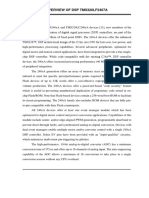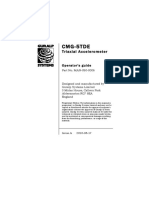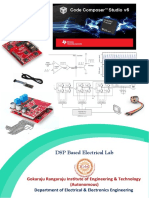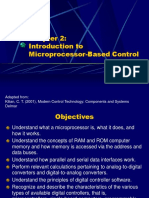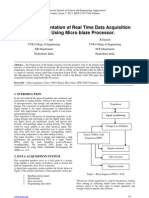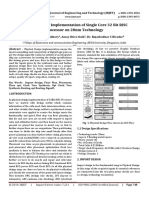DSP Hardware White Paper
DSP Hardware White Paper
Uploaded by
Sivaji MopideviCopyright:
Available Formats
DSP Hardware White Paper
DSP Hardware White Paper
Uploaded by
Sivaji MopideviCopyright
Available Formats
Share this document
Did you find this document useful?
Is this content inappropriate?
Copyright:
Available Formats
DSP Hardware White Paper
DSP Hardware White Paper
Uploaded by
Sivaji MopideviCopyright:
Available Formats
Real-Time DSP Data Acquisition for High-Speed Host Transfer
Introduction The architecture of a data acquisition system utilizing the processing capability of a DSP chip has existed for many years. The ability to do this in a local loop in real time is available today with chips such as the Texas Instruments1 floating-point TMS320C6713. The advantages of such an approach for real-time processing are many. But also of great interest is the ability for users to stream fast data rates to a host in an economical way. The new standard of USB2 2.0 allows high speed data transfer between such a DSP peripheral or standalone and a host PC. If such a DSP-based data acquisition system could use the highest accuracy data acquisition capability available today, and still transfer data at rates up to 480 Mbps, it would truly be a breakthrough. Current relative accuracy limits for data acquisition are 24-bit or 60 ppb. This combined with data rates as high as 100,000 measurements per second would provide breakthrough performance. A system architect could use such performance either in a local control loop or on a stream basis via the USB 2.0 communications link. This freedom of choice would solve many measurement challenges in industrial systems. For example, such an embedded system could perform signal processing and real-time control independently of the host or under the control of the host processor. Other key advantages of this type of system would be: Plug & play features of USB 2.0 provide a quick and easy way to have the data acquisition system up and running. Galvanic isolation can be implemented to protect the host computer from ground loops and voltage transients -- a capability not often found on data acquisition products. Galvanic isolation also helps to adhere to the tough CE requirements of EN50082-1:1998. Programs can be downloaded via USB 2.0 to on-board memory or flash.
The ideal operation of this real-time data acquisition system would allow simultaneous operation in real-time of all measurement subsystems at high throughput rates and high accuracy. The TMS320C6713 floating point DSP could read data from 24-bit sigma delta A/Ds, write data to 24-bit sigma-delta D/As, do digital input/output control operations, or use on-board 32-bit up/down counter timers, all simultaneously and in real-time. Scalability of these operations would also be possible by adding system boards with common clocks and triggers. Data would be either sent to the host using USB 2.0 or shared between processes with on-board 50MB per second LVDS ports. An additional benefit of the USB 2.0 communication mechanism would be that power or system operation is available as part of the connector mechanism. DT9841 Fulcrum II Series Data Translation has designed such a system, the DT9841 Fulcrum II Series. This paper will outline the design considerations and trade-offs made. To begin with, the on-board sub-systems are: USB 2.0 for connectivity to a Host Computer 100kHz, 24 Bit Analog to Digital Conversion 100kHz, 24 Bit Digital to Analog Conversion 24 Lines Digital Input / Output 32 Bit Counter Timers 300 MHz Floating Point DSP Processor 50 Mbyte/s LVDS Port for connectivity between modules
USB 2.0 provided the standard high-speed connectivity to numerous computers at speeds up to 480Mbits per second for downloading programs to the DSP processor and reporting or streaming data back to the host computer. For the processor we chose an 8-bit machine with an integrated state machine to independently move data through FIFOs to and from the USB pipes. The USB processor also does double duty in controlling the interface through the galvanic isolation barrier to the DSP chip. The TMS320C6713 was chosen for the DSP engine because of numerous hardware considerations in addition to the standard software tools available today. The Host Port Interface on the DSP provides a standard, high-speed interface to the USB processor for sending and receiving data. A feature not so obvious is that it is under control by the USB processor on boot up. This allows programs to be downloaded from the host PC to the DSP processor on power up. Another option would be to allow stand-alone operation with the boot-up from the on-board 2Mbytes of flash memory. A CPLD (Complex Programmable Logic Device) was used as the glue logic on the USB side of the isolation barrier because of the lower power and it powers up all already programmed and ready to go. On the DSP side of the isolation barrier an FPGA (Field Programmable Gate Array) is used for the glue logic. All subsystem data is passed to and from the DSP processor through the FPGA. This allowed for maximum flexibility in the current design and opens a wide range of options for the future, including preprocessing of the data in front of the DSP. Signal integrity is paramount in any high performance data acquisition system, especially at 24 bits of analog resolution and 100KHz conversion rates all on the same board with 300MHz clocks and high speed processing. We had considered standard plug-in modules but when you take under consideration the high frequency clocking on-board and the switching power supplies that were used in order to keep the heat down we decided on cold rolled steel cases to enclose and shield the analog circuits. These modules provide both electrostatic and electromagnetic shielding to all the critical analog functions. In addition the PC board is divided into several areas with power plane splits dividing the sub-systems in order to minimize cross talk between the analog and digital subsystems. Not only looking at signal integrity but protection of the host computer in the often harsh industrial environments, it was determined that galvanic isolation was a necessary. This type of isolation completely separates the grounds of the host computer system from all the I/O subsystems. The isolation barrier breakdown voltage must be greater then local line voltage in case of an inadvertent connection. On the signal integrity side, this type of isolation also prevents even microamperes of ground loop current that can cause errors in high resolution analog systems. Sigma-delta A/D and D/A converters were chosen to minimize the customer's signal conditioning requirements. The on-board filtering provided by this technology removes the need for external anti-alias filters in most applications. Of course this does introduce some delay between the time an analog signal changes and the digital output. This delay is referred to as the group delay and is predictable with the following expression for the A/D, (Group Delay = 37/FS). FS is the selected clock rate of the A/D converter and is 370 microseconds at 100kHz through-put. As it turns out this is almost the same delay that would be introduced by an analog anti-alias filter. Low Voltage Differential Signal (LVDS) devices for the external data path enabled the sharing of data among multiple boards for processing and stimulus to a wide range of vibration applications. This not only provided the speed and signal integrity but the low noise for passing the EMI requirements. This is yet another area we took advantage of the glue-less interfaces of the TMS320C6713, using a slower setting on the write than on the read when the LVDS subsystem chip enable is active. This insures that the FIFO on the receiving module does not overflow, even taking into consideration the latency of the interrupt service routine.
ID ROM
32Kb SRAM
Programmable Clock
Clock & Trigger BNCs
8-Differential Analog Inputs 68 Pin Connector 8-24 Bit Delta Sigma Analog to Digital Converters DT5768
2-24 Bit DAs 68 Pin Connector 2- 24 Bit Delta Sigma Digital to Analog Converters DT222
500 Volt Isolation Barrier
CPLD Control Logic USB USB 2.0 Interface INT Reset 4 Control Rd_Wr_L Input FIFO 16 Bit HPI Address/Data HINT_L
CGL
A/D Clock 8 Ch Serial Data D/A Serial Data INT5 D/A Ready A/D / DA Data INT6 A/D Done Reset 4 Control Lines Rd_Wr_L 16 Bit HPI Address/Data HINT_L
A/D Trig Ctr Over Dig Change INT4 LVDS Done AD DA Error
TMS320C6713 L2 Memory 64K Bytes
FPGA
16Mx32 SDRAM 16Mx32 SDRAM or 1Mx16 FLASH RAM
Isolation Interface
Ext Pwr + 5V@6A
Isolated DC-DC
FIFO
24 Lines DIO & 3 Counter Timers 68 Pin Connector
INT7 LVDS FIFO 14 pin JTAG
50 Pin 16 Bit LVDS Port
50 Pin 16 Bit LVDS Port
9 Pin Serial Port 1
FIG. 1 FUNCTIONAL BLOCK DIAGRAM OF DT9841 Starting the Subsystems Once the program is loaded the subsystems can be started with an internal or external trigger and clocked with an internal or external clock for synchronization. Again this is where another hardware consideration comes in with the selection of the TMS320C6713. Interrupts from the subsystems are dedicated to the servicing and movement of real-time data under DMA control. For example interrupt 5 would initiate a DMA transfer to output another point of data to the on-board D/A converters or interrupt 6 would initiate a DMA transfer to collect another data sample from an A/D converter or even do a simultaneous snap of all eight A/D converters along with all counter values and digital inputs. This all takes place in the background while the DSP chip is performing calculations or moving results up to the host computer through the USB 2.0 interface. Firmware The firmware and operating system are loaded on power-up through the USB 2.0 interface from the host computer to the memory on the DSP side of the board. The USB controller holds the DSP processor in reset until the memory is loaded. When the reset line is released the DSP program starts. Once started, one of the TMS320C6713 timers is used to interrupt the processor to check for commands from the host or let the host know that there is data ready. A key feature here is that a bit is set and reset each time the counter loops, allowing for a heart beat to be monitored by the host, insuring the process is still running. This heart beat signal is also divided down to drive a LED on the front panel for a quick indicator for the operator. In addition the on-board firmware can be setup to run stand-alone if communication is lost to the host placing critical data into flash memory.
FIG. 2 DT9841 FULCRUM II SERIES WITH TI C6713 FLOATING-POINT DSP Debug A JTAG port has been provided for debug and software development using standard tools such as the Blackhawk emulator and Code Composer. However a second key feature that is not included in the block diagram is a bank of eight LEDs on the board that are memory mapped through the FPGA so that a programmer can set and reset up to 255 visible flags in hardware as the program progresses. This way even if the program locks up the LED flags will give a quick hardware indication where the program was. Regulatory Consideration for harsh industrial environments and the tough FCC and CE requirements must be done early in the design cycle. Galvanic isolation to the host computer along with hand optimized multi-layer printed circuit board design is key to meeting these requirements. This is above and beyond the normal resistor / diode, transient protection on all the I/O lines. Ease of Use On initial set-up the Plug & Play capability of USB 2.0 allows the user to get the DT9841 module up and running quickly, downloading and executing example programs to the DSP. Calibration is software controlled and saved in on board non-volatile memory. In addition set-up information such as LVDS termination resistors and analog input bias return resistors are also software programmable and stored in on-board non-volatile memory. Thinking about the final package, depending on how many modules are in a system and the enclosure used, we also took into consideration the heat rise. There is a bit in a register to warn if the temperature exceeds 60 degrees centigrade. Additionally there is a FET switch connected to a plug to switch on a low power fan for cooling if the temperature exceeds 45 degrees centigrade. Conclusion This confluence of system architecture components will allow high-speed performance at low-cost in a standard system configuration. Users who need to do real-time data acquisition would benefit by the combination of the high-speed performance capabilities available today with the ability to transfer data to and from the host PC at high data rates. The performance of a floating point chip such as the TI 6713 allows accurate real time processing of signals in a system configuration that would be of great benefit to the user.
References [1] Texas Instruments Website: www.ti.com. [2] USB Website: www.usb.org.
You might also like
- Manual Phonic Impact MixerDocument36 pagesManual Phonic Impact MixerRicardo RamosNo ratings yet
- First Quarter Exam in CHS 7Document5 pagesFirst Quarter Exam in CHS 7Rio OcampoNo ratings yet
- Answer - Amplitude ModulationDocument11 pagesAnswer - Amplitude ModulationRichard RegidorNo ratings yet
- DSP System DesignDocument35 pagesDSP System DesignLokesh KumarNo ratings yet
- Secure Data CommunicationDocument11 pagesSecure Data CommunicationNeela ChennurNo ratings yet
- Advanced Power Technology and Services J.S.C. Advanced Power Technology and Services J.S.CDocument10 pagesAdvanced Power Technology and Services J.S.C. Advanced Power Technology and Services J.S.CQuang NgocNo ratings yet
- Unit 4 Dap New 1 ST HalfDocument15 pagesUnit 4 Dap New 1 ST Halfitsmehema12No ratings yet
- Reference Material For EXP - 1Document26 pagesReference Material For EXP - 1Jatin YadavNo ratings yet
- 25.ACCESSIBLE DISPLAY DESIGN TO CONTROL HOME AREA NETWORKSDocumentDocument84 pages25.ACCESSIBLE DISPLAY DESIGN TO CONTROL HOME AREA NETWORKSDocumentdileeppatraNo ratings yet
- Novus Daq (Eng)Document6 pagesNovus Daq (Eng)projgoNo ratings yet
- DA 9000 Tech SpecDocument9 pagesDA 9000 Tech SpecJenrri Herhuay Huaman100% (2)
- Base Band Modem Hardware Design: P. Antognoni, E. Sereni, S. Cacopardi, S. Carlini, M. ScafiDocument5 pagesBase Band Modem Hardware Design: P. Antognoni, E. Sereni, S. Cacopardi, S. Carlini, M. Scafikokome35No ratings yet
- DSP Lab ManualDocument26 pagesDSP Lab ManualMadhan ReddyNo ratings yet
- Project Report DASDocument59 pagesProject Report DASmknunwalNo ratings yet
- PC To PC Optical Fibre CommunicationDocument7 pagesPC To PC Optical Fibre CommunicationPolumuri LovakumarNo ratings yet
- P2LPC-Koncentrator Ang UKDocument2 pagesP2LPC-Koncentrator Ang UKadenijisegunNo ratings yet
- PCT Manual 2.3.1Document115 pagesPCT Manual 2.3.1SzefElityNo ratings yet
- How To Implement DSP Algorithms Using The Xilinx Spartan 3E Starter BoardDocument7 pagesHow To Implement DSP Algorithms Using The Xilinx Spartan 3E Starter BoardShahzad SaleemNo ratings yet
- CMG-5TDE ManualDocument14 pagesCMG-5TDE ManualIsa EyyubovNo ratings yet
- Dire Dawa University Institute of TechnologyDocument28 pagesDire Dawa University Institute of TechnologyAsed ZakirNo ratings yet
- D Module c6713Document11 pagesD Module c6713cristian_chituNo ratings yet
- ATM Terminal Design Based On Figure Print Recognition DocuDocument115 pagesATM Terminal Design Based On Figure Print Recognition DocuPraveen NaiduNo ratings yet
- Intellignt Instrumentation NotesDocument13 pagesIntellignt Instrumentation NotesBarun DhimanNo ratings yet
- Applications: Product Bus Operating System Channels Max. Sample Rate Bandwidth Memory Per Channel ResolutionDocument9 pagesApplications: Product Bus Operating System Channels Max. Sample Rate Bandwidth Memory Per Channel ResolutionVENKATESH KAMATHNo ratings yet
- Paper By:: Thunuguntla Gayathri Vusthepalli SravaniDocument7 pagesPaper By:: Thunuguntla Gayathri Vusthepalli SravaniNaga Neelima ThunuguntlaNo ratings yet
- Data Acquisition Systems: Assignment EC375-Measurements and InstrumentationDocument10 pagesData Acquisition Systems: Assignment EC375-Measurements and InstrumentationAfrasinei Sergiu VladNo ratings yet
- FPGA Based System Design Suitable For Wireless Health Monitoring Employing Intelligent RF ModuleDocument4 pagesFPGA Based System Design Suitable For Wireless Health Monitoring Employing Intelligent RF Modulechaitanya sNo ratings yet
- Iskraemeco - Data Sheet P2LPC-Koncentrator AngDocument4 pagesIskraemeco - Data Sheet P2LPC-Koncentrator AngSuttisak SuriyachanhomNo ratings yet
- Final DSP Lab 2-06-12Document92 pagesFinal DSP Lab 2-06-12Anonymous Ndsvh2soNo ratings yet
- Unit 3 System Interfacing and ControllersDocument48 pagesUnit 3 System Interfacing and ControllersSrinivasan V PNo ratings yet
- Scout 8-26-10Document2 pagesScout 8-26-10Jed TedorNo ratings yet
- 1252 DatasheetDocument3 pages1252 DatasheetSK PNo ratings yet
- Unit-2: Data Acquisition System (DAS)Document10 pagesUnit-2: Data Acquisition System (DAS)Barun DhimanNo ratings yet
- DSP LabmanualDocument82 pagesDSP LabmanualHemanth SharmaNo ratings yet
- Scadapack 330 Scadapack 334 DatasheetDocument4 pagesScadapack 330 Scadapack 334 DatasheetAqua Technology GroupNo ratings yet
- DSP Based Electrical Lab: Gokaraju Rangaraju Institute of Engineering & Technology (Autonomous)Document77 pagesDSP Based Electrical Lab: Gokaraju Rangaraju Institute of Engineering & Technology (Autonomous)P Praveen KumarNo ratings yet
- IDT72V8988 - DataSheetDocument14 pagesIDT72V8988 - DataSheetDang KhueNo ratings yet
- Laptop SchematicDocument111 pagesLaptop SchematicnegrusrlNo ratings yet
- DSP NotesDocument6 pagesDSP NotesSringaSyamNo ratings yet
- Bus Tracking Using Gps & GSM SystemDocument30 pagesBus Tracking Using Gps & GSM SystemAnindya RoyNo ratings yet
- A Reconfigurable Digital Signal Processing SystemDocument6 pagesA Reconfigurable Digital Signal Processing Systempym1506gmail.comNo ratings yet
- Advance Embedded System Design: Shibu K VDocument73 pagesAdvance Embedded System Design: Shibu K VBhavya Reddy75% (4)
- DSP Blocks InterfacingDocument30 pagesDSP Blocks Interfacingdolly aryaNo ratings yet
- Design Choices - EthernetDocument29 pagesDesign Choices - EthernetJasmine MysticaNo ratings yet
- GeoSIG RecorderDocument2 pagesGeoSIG RecorderrezaghadimNo ratings yet
- Digital Signal Processing Lab MannualDocument37 pagesDigital Signal Processing Lab Mannualsreenathreddy100% (4)
- Introduction To Microprocessor-Based ControlDocument42 pagesIntroduction To Microprocessor-Based ControlAhdan Fawwaz100% (1)
- Mobile Lab ManualDocument56 pagesMobile Lab Manualnaitikkapadia100% (1)
- Ti330 Tech Circuit ManualDocument3 pagesTi330 Tech Circuit ManualMauro PrestipinoNo ratings yet
- 10 Mbps ARCNET (ANSI 878.1) Controller With 2Kx8 On-Board RAMDocument89 pages10 Mbps ARCNET (ANSI 878.1) Controller With 2Kx8 On-Board RAMGoh Seng TakNo ratings yet
- PC To PC OPTICAL FIBRE COMMUNICATIONDocument7 pagesPC To PC OPTICAL FIBRE COMMUNICATIONpallaishashankashekharNo ratings yet
- 7521 ServiceManualDocument122 pages7521 ServiceManualRicardo Alexis Fuentes LufittNo ratings yet
- Panashe Mushinyi H180524V SE Department Microprocessor and Embeded Systems Assignment 1 and 2Document6 pagesPanashe Mushinyi H180524V SE Department Microprocessor and Embeded Systems Assignment 1 and 2panasheNo ratings yet
- Peripherals of Tms320pc54xDocument10 pagesPeripherals of Tms320pc54xlogesh loguNo ratings yet
- Index: A. About KielDocument73 pagesIndex: A. About KieldileeppatraNo ratings yet
- Datasheet MODM7AE70 100 200IRDocument13 pagesDatasheet MODM7AE70 100 200IRBenny LangstonNo ratings yet
- Honeywell ALerton LTBT-VLXDocument2 pagesHoneywell ALerton LTBT-VLXVo Dai NgocNo ratings yet
- FPGA Implementation of Real Time Data Acquisition System Using Micro Blaze Processor.Document4 pagesFPGA Implementation of Real Time Data Acquisition System Using Micro Blaze Processor.ATSNo ratings yet
- PLC: Programmable Logic Controller – Arktika.: EXPERIMENTAL PRODUCT BASED ON CPLD.From EverandPLC: Programmable Logic Controller – Arktika.: EXPERIMENTAL PRODUCT BASED ON CPLD.No ratings yet
- The complete guide to Hardware Technician Terminology: A simplified guideFrom EverandThe complete guide to Hardware Technician Terminology: A simplified guideNo ratings yet
- ANKO h264 Series DVR User Installation Operation ManualDocument61 pagesANKO h264 Series DVR User Installation Operation ManualartcreativeNo ratings yet
- TRANSMISSION LINES Part 2 3Document53 pagesTRANSMISSION LINES Part 2 3Em ReyesNo ratings yet
- Interrupt Interface of The 8088 and 8086 MicroprocessorDocument32 pagesInterrupt Interface of The 8088 and 8086 Microprocessorkaram hayderNo ratings yet
- Physical Design Implementation of 32bit RISC Processor Using Synopsys ICC Primetime & StarRC XTDocument6 pagesPhysical Design Implementation of 32bit RISC Processor Using Synopsys ICC Primetime & StarRC XTFeroz AhmedNo ratings yet
- A Review of Stepped Impedance Resonators in Microwave CircuitsDocument8 pagesA Review of Stepped Impedance Resonators in Microwave CircuitsyyryNo ratings yet
- 74 Series IC Data Sheet IndexDocument5 pages74 Series IC Data Sheet Indexkranthikiran211No ratings yet
- JVC DT-V100CG BrochureDocument2 pagesJVC DT-V100CG BrochureluyiranNo ratings yet
- Q2 Week 5 LogicGatesDocument18 pagesQ2 Week 5 LogicGatesgandaday1221No ratings yet
- Department of Physics and Nanotechnology SRM Institute of Science and TechnologyDocument76 pagesDepartment of Physics and Nanotechnology SRM Institute of Science and Technologyvivekk132005No ratings yet
- VLSI Digital Signal Processing Systems by Keshab K ParhiDocument25 pagesVLSI Digital Signal Processing Systems by Keshab K Parhirahil1650% (4)
- Boston Acoustics SoundWareXS 51 ManualDocument7 pagesBoston Acoustics SoundWareXS 51 ManualbadhwarpuneetNo ratings yet
- Microprocessor NotesDocument60 pagesMicroprocessor NotesVijay KumarNo ratings yet
- Analytical Modeling of Exposure Process in Pinned Photodiode CMOS Image SensorsDocument9 pagesAnalytical Modeling of Exposure Process in Pinned Photodiode CMOS Image SensorsJackNo ratings yet
- Horn AntennaDocument2 pagesHorn Antennaprashant4455No ratings yet
- Wireless Wire Cube: A 2 GB/S 60 GHZ Aggregate Link With A 5 GHZ Failover. Forget About Wires or Downtime!Document4 pagesWireless Wire Cube: A 2 GB/S 60 GHZ Aggregate Link With A 5 GHZ Failover. Forget About Wires or Downtime!Freddy BohorquezNo ratings yet
- AC Input: Circuit Diagrams and PWB LayoutsDocument6 pagesAC Input: Circuit Diagrams and PWB LayoutsJefferson LeiteNo ratings yet
- Powermate 0 Maintenance Manual PDFDocument227 pagesPowermate 0 Maintenance Manual PDFmrtans100% (1)
- Self-Study Programme 256: ServiceDocument32 pagesSelf-Study Programme 256: ServiceMohd FairusNo ratings yet
- Microstrip Patch AntennaDocument23 pagesMicrostrip Patch AntennaKaluwaNo ratings yet
- AIC IAT - 1 Answer KeyDocument2 pagesAIC IAT - 1 Answer KeyHeeraNo ratings yet
- Sc3 Lecture Short CKT Currents BMR Feb.03, 2021Document11 pagesSc3 Lecture Short CKT Currents BMR Feb.03, 2021Khizer AminNo ratings yet
- Read Me First (A Synopsis of The User Manual) : RNB100 TabletDocument2 pagesRead Me First (A Synopsis of The User Manual) : RNB100 Tabletrugged_mikeNo ratings yet
- Automatic Bike Stand ReportDocument50 pagesAutomatic Bike Stand ReportSagar Tikone33% (3)
- Daewood Hc6120uDocument40 pagesDaewood Hc6120uAna Six100% (1)
- Data Types and Memory AllocationDocument11 pagesData Types and Memory Allocationeugenecc736No ratings yet
- Devais Elektronika SAPDocument2 pagesDevais Elektronika SAPMesah Yoga KarismaNo ratings yet
- Two-Wire Peripheral Expansion For The AT89C2051 MicrocontrollerDocument9 pagesTwo-Wire Peripheral Expansion For The AT89C2051 MicrocontrollerVlaovic GoranNo ratings yet







